Last Wednesday night saw Philadelphia Union leapfrog NY Red Bulls to go top of the MLS Eastern Conference. A 2-1 victory over Inter Miami, managed by ex-Everton and Manchester United player Phil Neville, and a win for NYCFC dropped the Red Bulls down to third. A 2-1 follow-up win for The Union on Saturday at home to New England Revolution keeps them top by a point with 13 games remaining.
Head coach Jim Curtin, who spent seven years playing for the Chicago Fire, has been in charge since 2014 and has led the Union to three US Open Cup finals. Last season, the 43-year-old’s side finished in second place in the Eastern Conference. Although a respectable league position, they were a very distant 19 points behind conference champions New England Revolution.
This season, they are hoping to go one better in conference play as well as avenge their play-offs semi-final defeat. Having scored 11 goals in their previous three matches, the Pennsylvanians are in a good position to do so.
This analysis will be presented in the form of a scout report. The focus will be on Philadelphia Union’s positional attacks, their use of the long ball and the positioning and movements of their attacking midfielder. In this tactical analysis, we analyse the key tactics behind the Philadelphia Union’s rise to the top of the 2022 MLS Eastern Conference.
Statistical analysis
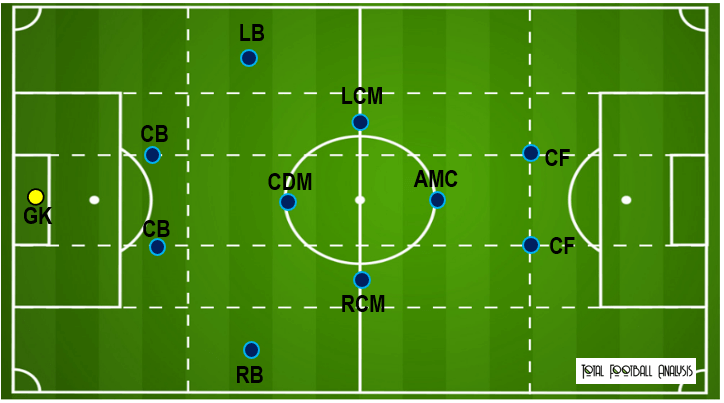
As the above tactical diagram shows, Curtin usually sets his side up in a 4-4-2 diamond formation. However, in their most recent match, against New England Revolution, which will be covered in this analysis, they used a 4-2-3-1.
Philadelphia have accrued 39 points in their 21 matches this season, overperforming their expected points by 6.6 points. Their expected points tally of 32.4 would place them second in the eastern conference, behind New York City, and third in the combined MLS table.
Despite scoring 11 goals in their previous three matches, Philadelphia are only 8th in the MLS for goals scored with 33. They are all the way down in 12th for expected goals with an xG of 29.54 – over three goals less than they have actually scored. Prior to their recent goalscoring exploits, which were greatly aided by a 7-0 thrashing of a very poor DC United side, Curtin’s team were averaging just 0.81 goals per match.
Central attacking midfielder ‘6’ Dániel Gazdag is Philadelphia’s top scorer with nine goals. The Hungarian international is also the club’s highest for goals and assists combined with 11. This places him only joint 13th in the MLS. Left-back, ‘27’ Kai Wagner leads the team, and the MLS, in assists alone with 7.
Having scored a relatively low amount of goals for a team sitting at the top of the league, and a third of those goals coming in just three matches, it is Philadelphia’s goals conceded that sets them apart from the rest of the league. Their 15 goals conceded is six better off than the next best, with the New York Red Bulls, LAFC, and New York City all having conceded 21. Whilst still an impressive defensive output, their xG against is significantly higher at 24.54. Had they matched their xG against, they would only have conceded the sixth-fewest goals in the league.
The Union’s ball possession is the second lowest in the MLS with them seeing, on average, just 41.7% of the ball. Only 10th placed (in the Western Conference) Vancouver Whitecaps have a lower average possession of 41.5%. Philly also have the lowest number of passes per 90 minutes averaging 289.14 per match. This is well below the league average of 387.83. Out of the 28 MLS teams, Philadelphia complete the fourth most long passes per 90 mins averaging 40.75 per match with an accuracy of 57.8%. This deliberate and effective long ball tactic will be covered in the next section.
Philadelphia’s 2-1-2-5 positional attack and long diagonals
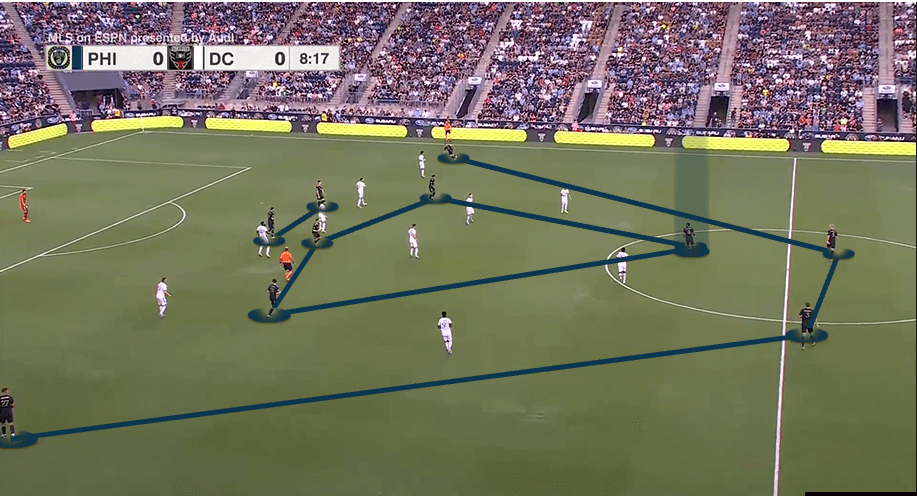
As mentioned in the section above, Philadelphia often play long balls from back to front. These have been very effective and have contributed to several goals in their recent matches. Often, these passes occur after lengthy passing sequences when the opposition is pinned in their defensive third, rather than hopeful clearances out of the back.
The above image shows Philly in their 4-4-2 diamond shape which has become something of a 2-1-2-5 formation. Five players, both forwards, both full-backs and three of the four midfielders are playing on or close to the opposition’s back-line. The sustained positional attack lasted for over a minute with the ball being switched from side to side twice before the long ball was played.
With all five of the opposition’s back-line in a one-on-one situation, the DMC hits a long ball for his teammate, ‘11’ Alejandro Bedoya, who is in the right-back position. This pass bypasses the opposition’s midfield block, rendering half the team obsolete.
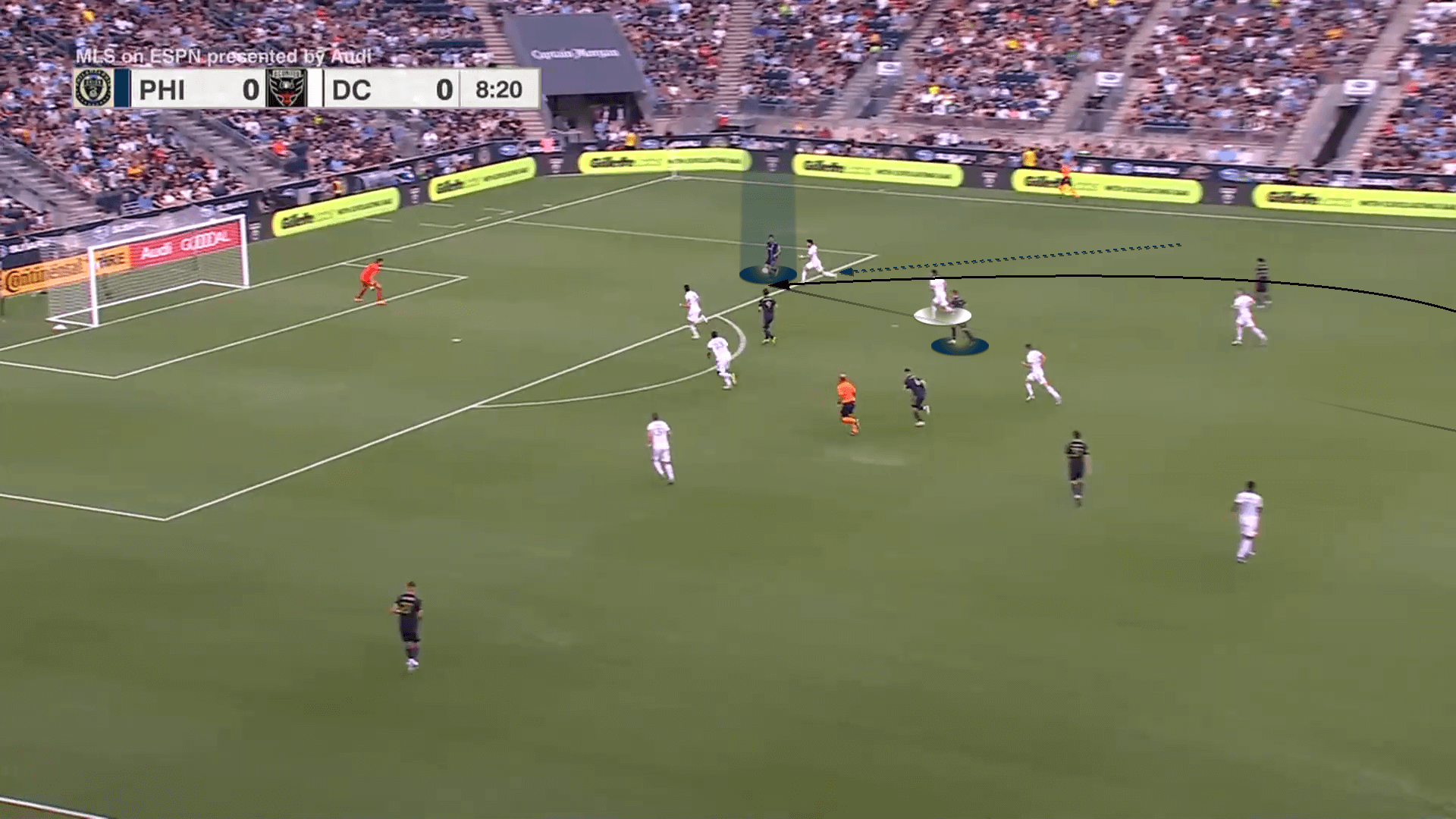
The DMC plays the ball over the midfield and in between the opposition’s left wing-back and left-sided centre-back. With one of the central forwards (highlighted) occupying the ball side centre-back (highlighted), this creates a foot race between the wing-back and Bedoya.
Bedoya, who has speed, is also the favourite to reach the ball first as he is facing in the correct direction and does not have to turn like his direct opponent. He does reach the ball first and, via one pass, is put through on goal to open the scoring.
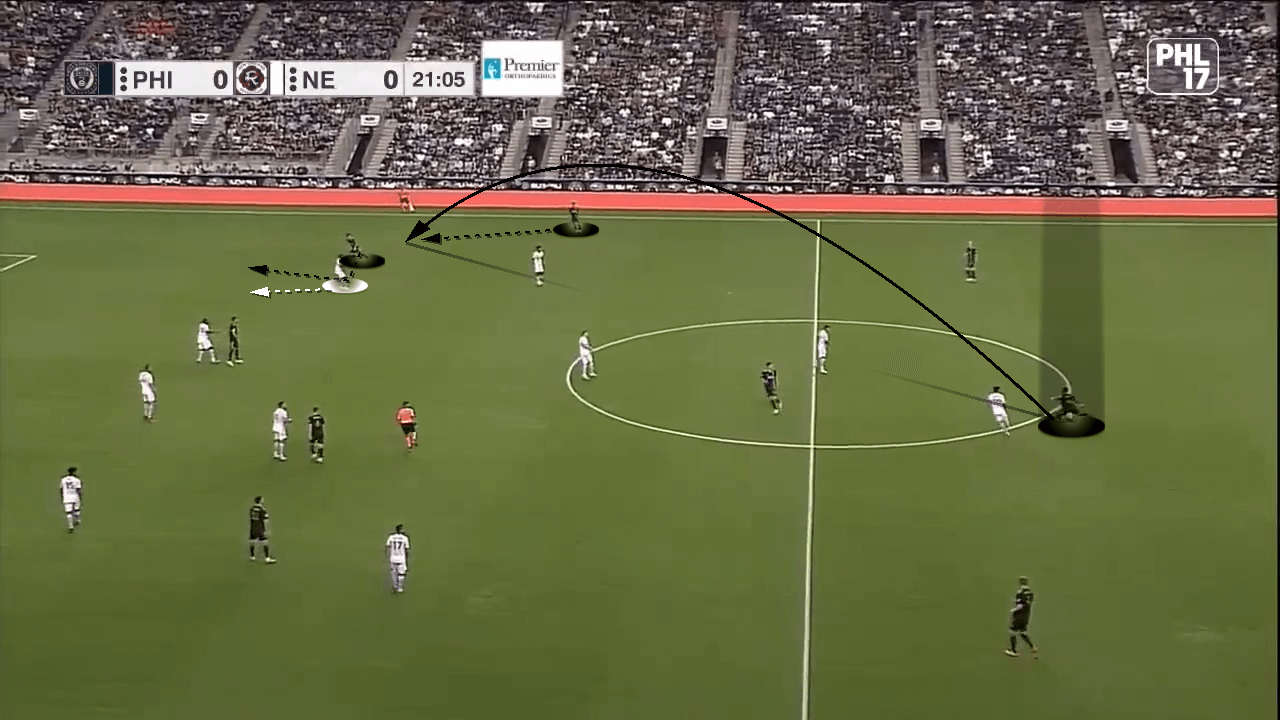
The above example shows Philadelphia in a similar situation but with the ball and the opposition’s back-line 20-yards further from goal. On this occasion, Philly is playing in a 4-2-3-1 and one defensive midfielder has dropped between his centre-backs to receive the ball.
The right-winger makes the same movement as Bedoya did in the previous example but this time the run is just a decoy. The winger’s movement pushed the opposition left-back back towards his own goal and allows Philly’s right-back to receive the ball in space.
When the right-back receives the ball, his midfielders flock to the area to support him and the opposition is then penned in their defensive third. From this position, Philadelphia can play shorter combination passes that eventually lead to a shot on goal.
As highlighted in the statistics section, Philadelphia play more long balls than most of the teams in the league and a significant amount of their non-set-play chances come from these situations. It allows them to bypass opposition players and get the ball into areas where it is safe to play.
Philadelphia’s attacking midfielder in a 4-4-2 diamond
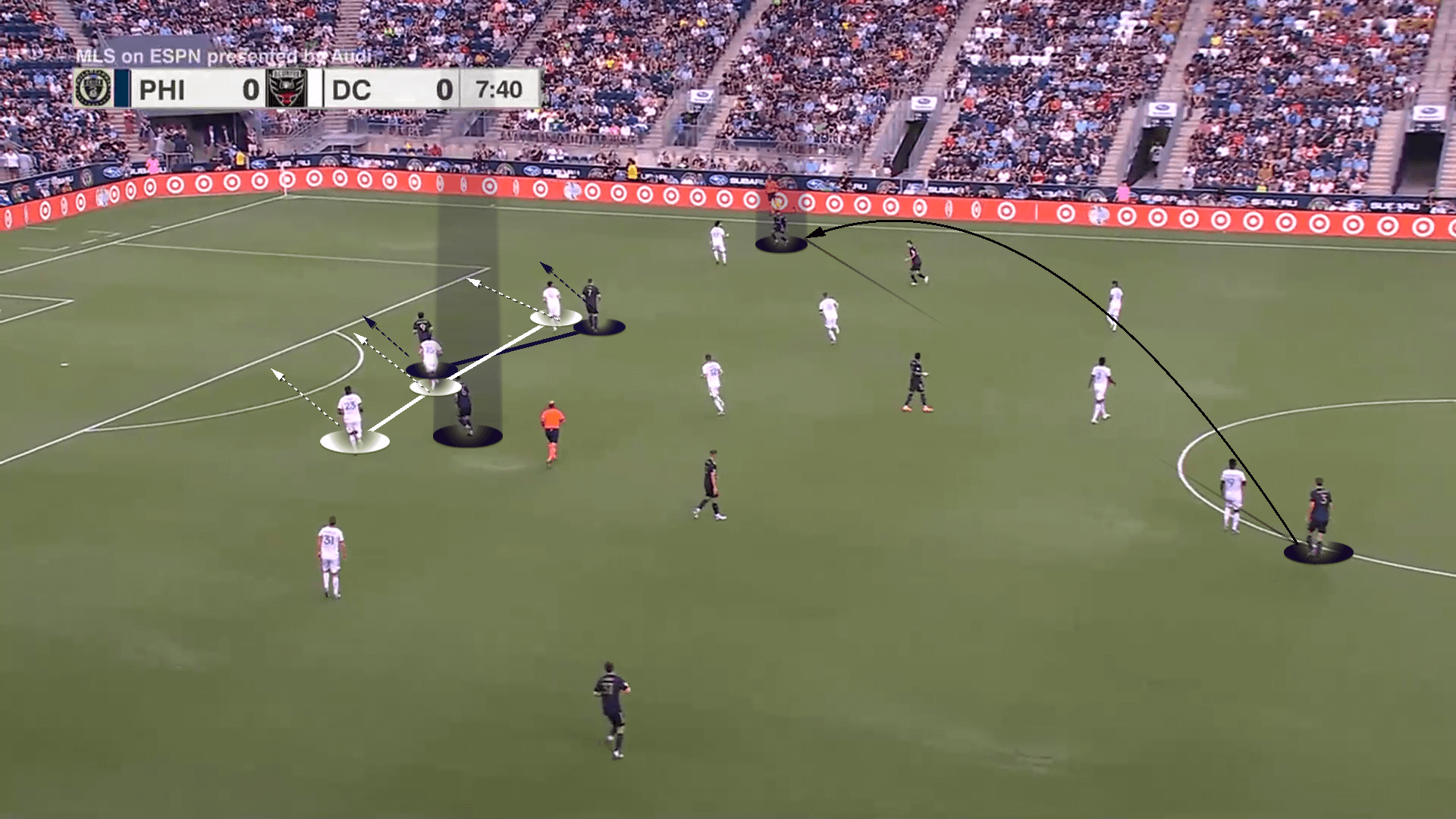
The above image shows Philadelphia, in their 4-4-2 diamond formation, during a sustained positional attack against DC United, who are playing in a 3-4-3. As is typical when they play this formation, Gazdag plays high and very close to his two forwards.
Like the plays described in the previous section, this attack began with a long diagonal from Philadelphia’s centre-back to his right-midfielder who had drifted out wide. As the ball was travelling in the air, the two central forwards, who were playing up against the left and central centre backs, made runs beyond the backline.
This movement pushed the centre-backs towards their own goal creating space between the lines where Gazdag could receive the ball. Because his starting position is so high, the opposition midfielders cannot pick him up.
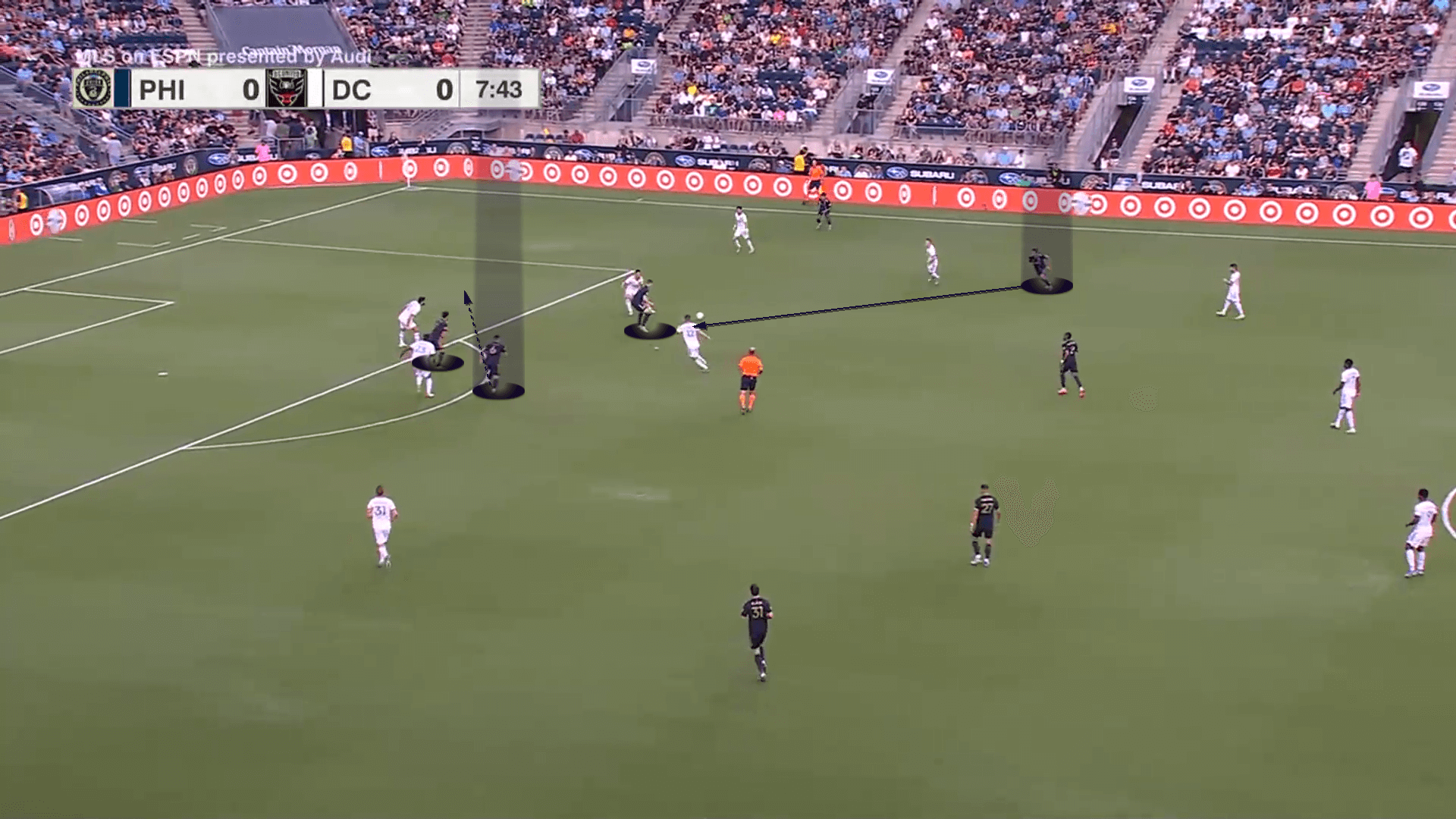
The right midfielder laid the ball back to his inverted right-back. The ball-near forward made a double-movement, away then towards the ball to receive it from his right-back. As the ball was travelling to the forward, Gazdag made a run in between the forwards.
The receiving forward allowed the ball to go between his legs for Gazdag to run onto and enter the box. With the left-sided centre-back drawn to the ball and the central centre-back screened by the ball-far forward, Gazdag was able to receive the ball alone.
It is the close proximity of Gazdag to his forwards that allows them to manipulate the space, by moving and screening defenders, to the benefit of Gazdag. It also means the three attacking players are close enough to combine when they receive the ball.
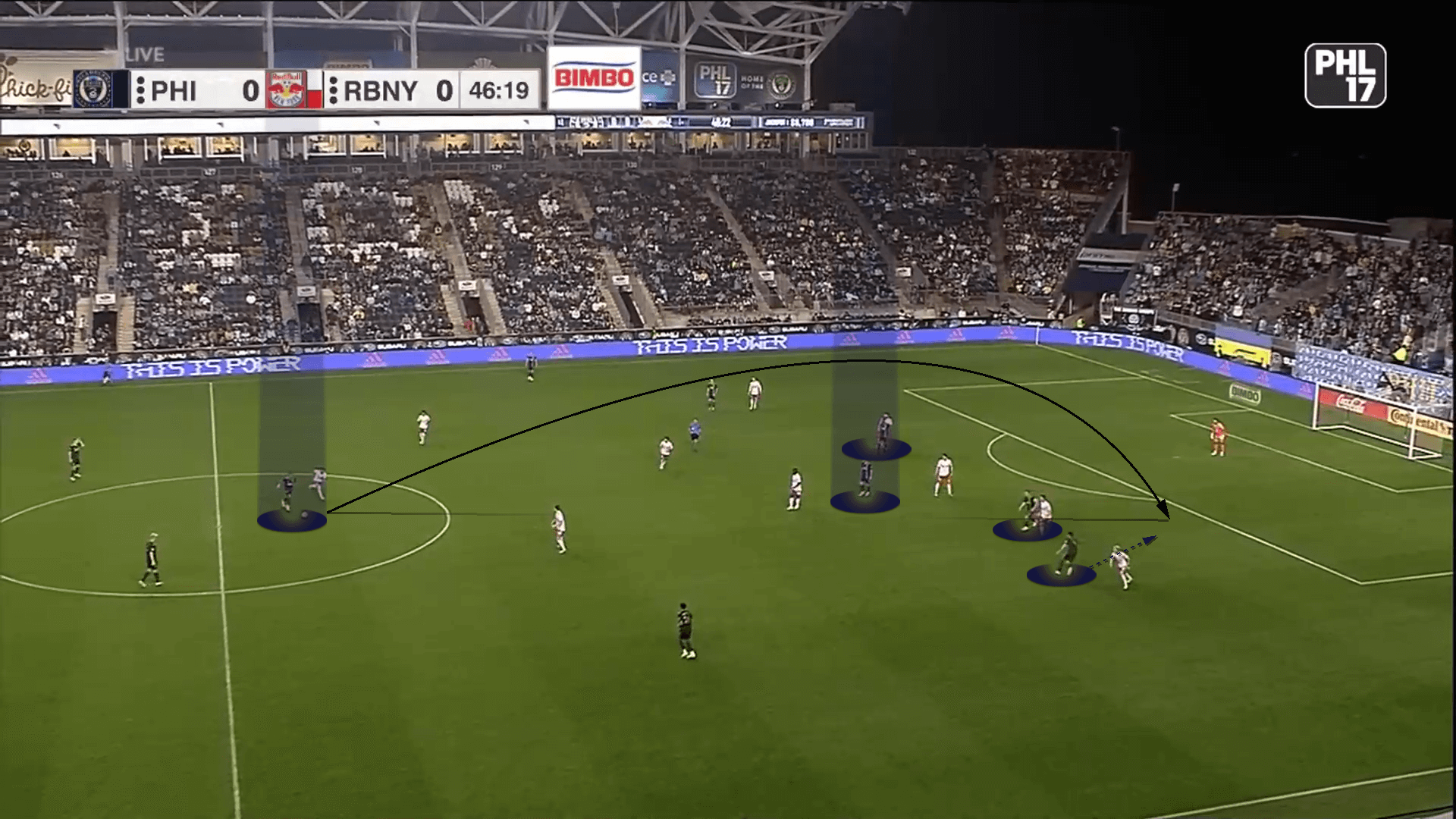
The above image again shows Philadelphia in what is close to a 2-1-2-5 formation during a sustained positional attack. This time, it is against the New York Red Bulls who, like DC United, played with a back three.
One of Philly’s forwards and their right-midfielder are occupying the two Red Bull side centre-backs. Central forward, ‘9’ Julián Carranza, has moved slightly wider and is playing up against NYRB’s left wing-back. Gazdag, whilst still close to his forwards, has dropped in between the lines.
Although the ball is at a distance where Gazdag is not an immediate threat as he is unlikely to receive the ball, the central centre-back would be unable to press him if he did receive it. The central centre-back cannot step out due to the two players pinning the side centre-backs and screening the area between them. If he gets tight to Gazdag, the ball would be played over his head and the forwards would be through on goal.
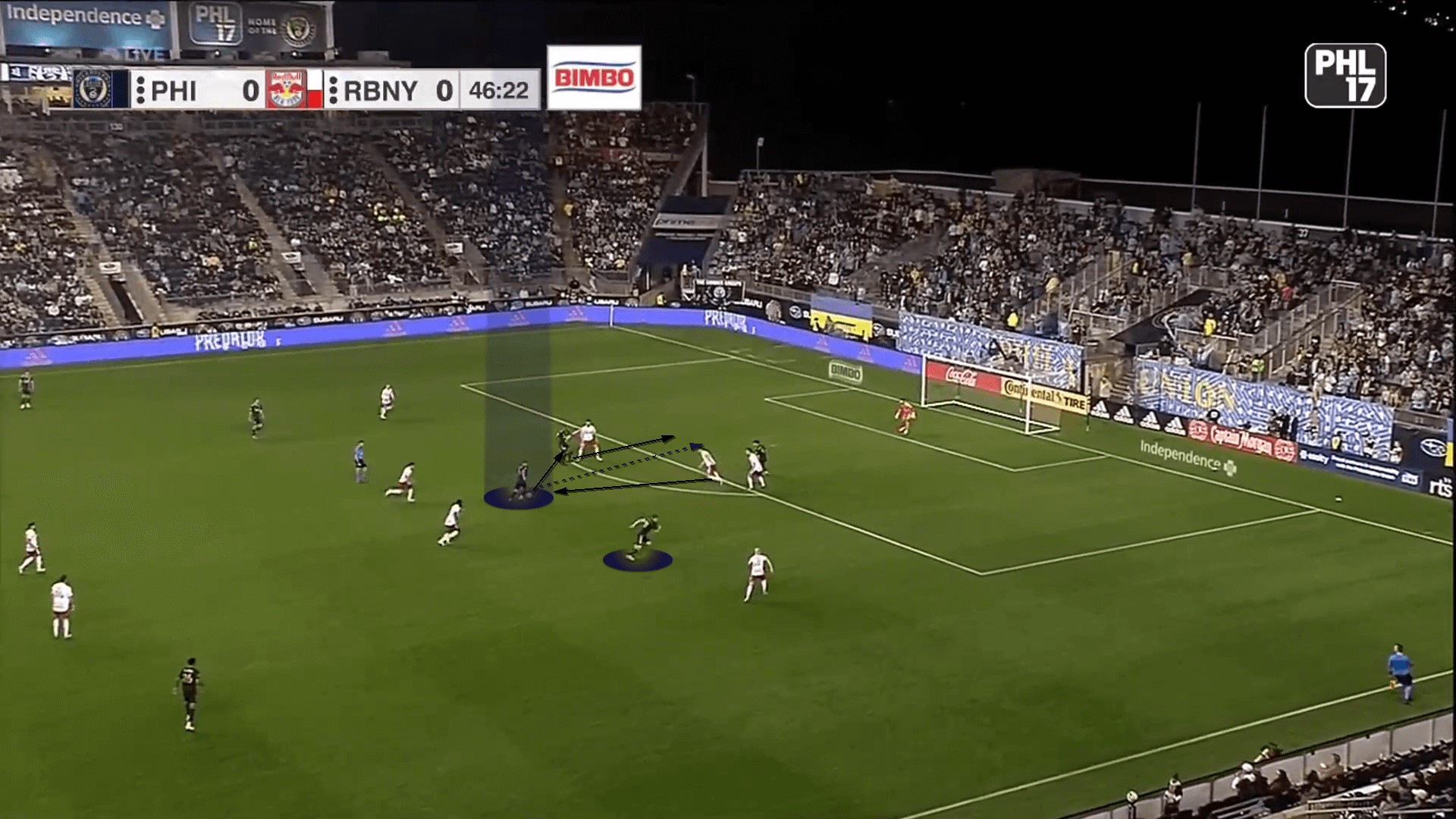
The above image shows the effectiveness of Gazdag playing so close to his forwards even from long balls. With the side centre-back having to track Carranza’s run in behind, the central centre-back has to drop to head the ball clear.
As the ball was in the air, the right midfielder and Gazdag ringfence the area to collect the second ball. The centre-back, backtracking and unable to get distance on his header, lays the ball straight back to Gazdag. The attacking midfielder then plays a quick one-two with his forward and is played through on goal to score the opening goal.
Conclusion
Although Philadelphia spend large periods of matches without the ball, they are very comfortable with it and have well-thought-out passages of play. For a team with such low possession percentages and a high amount of long balls, especially for a side sitting top of the league, their playing style is a lot more pleasing to the eye than may be expected.
Curtin’s playing style is also deadly effective. It allows his side to build sustained attacks without putting themselves under any undue pressure. Although they are currently outperforming many of their metrics, it is by no means luck that they find themselves in such a promising position. Perhaps this is the year Curtin and his team can go one step further in their quest for the MLS Cup.






Comments